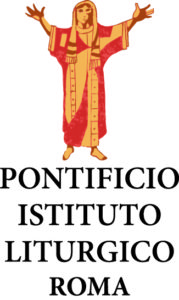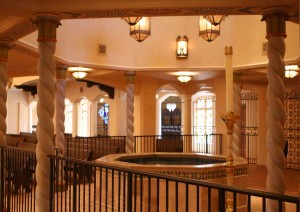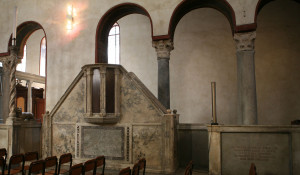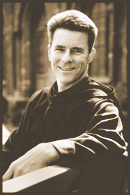Architecture for Liturgy II
second Litury Week
22-26 January 2018
Monday lunch to Friday lunch
at the
Spiritual Life Center
Wichita, Kansas
 under the
under the
Patronage of the
Pontifical Liturgy
Institute,
Rome
This week is intended for those who attended the first week Architecture for Liturgy I. Download a flyer (forthcoming) and pass it on to your friends.
Liturgy Week 1 and 2
Celebrating liturgy involves bodily actions that narrate the mysteries celebrated. This bodily narration determines not only the functional aspects of church design, but even more importantly, the inner dimensions inherent in the ritual narrative are expressed outwardly through an artistic program well integrated into the architectural design and arrangement of churches.
Much attention is given to the design of functional and even transcendent buildings, but insufficient attention has been given to developing a prolonged ritual narration whose every element expresses in synthesis the whole mystery celebrated by rites, symbols and texts proper to each element, all of which is determinative of the design and arrangement of church buildings and their artistic programs.
The First Liturgy Week Architecture for Liturgy I begins with a pictorial journey through the ancient basilicas of Rome. Next, we consider several different arrangements for churches that arose during the discussions held at the Second Vatican Council (1962-1965). From these we shall consider the three primary human experiences and their respective places: personal illumination with light in the baptistery and font, ongoing maturation by the word in the hall and at the ambo, interpersonal communion through consummation at the dais and altar-ciborium. Both liturgy weeks include visits to selected churches with guided discussions on the liturgical principles realized, and not yet fully realized.
The Second Liturgy Week Architecture for Liturgy II begins with the distinction between allegory and sacramental symbol. Most of the week is spent considering the inner dynamics of liturgy according to four pairs: memorial-imitation, presentation-invocation, moral and eternal life, sharing in divine life. The goal of both liturgy weeks is the development of a “Ritual Model”, which consists of the liturgical principles guiding the ritual celebration of liturgy and the expression of its inner meaning through artistic programs integrated into the architectural design of a church.
Liturgy Week 1 and 2 are designed for:
⋅ Parish planning groups preparing to renovate or build a church or chapel,
⋅ Architects and artists seeking a commission for a renovated or new church,
⋅ Architects wishing to design a building that supports a fuller ritual narrative and integrates better its artistic program,
⋅ Artists seeking inspiration from dimensions inherent to the bodily celebration of rites for more integrated and fuller artistic programs,
⋅ Diocesan directors of offices of worship or commissions that govern the building or renovation of churches,
⋅ Pastors wishing a more universal, historical and thus catholic perspective for the design phase of building or renovating a church.
⋅ Liturgists wishing to develop the ritual narration of celebrating liturgy,
⋅ Ecumenical partners seeking our common tradition, sharing the recent liturgical renewal and considering our differentiated practices.
The presentations are clear, given in ordinary language for the informed person and are richly illustrated by pictorial journeys. This accessibility gives direct and immediate access to the inner dimensions of liturgical celebrations.
Learning Goals
Participants will come to understand the conversation surrounding the Second Vatican Council about different arrangements of churches for the celebration of liturgy.
Participants will learn to evaluate the pastoral benefits and the ritual limitations of each arrangement.
Participants will further consider the ritual model as a more comprehensive synthesis of the benefits of these various arrangements and learn to evaluate the design of any specific based on this ritual model. This was first presented in Liturgy Week 2015.
Participants will learn the four interpretative keys and learn to perceive these in any liturgical action.
Participants will understand the many different ways in which these four interpretative keys intrensic to the rite are expressed in the artistic narrative and the architectural design of a church.
Participants will visit three different churches and discuss the arrangement of each church in light of the discussion surrounding Vatican II. They will interpret the arrangement of each in light of the four interpretative keys.
Drawing on the presentation given in the first week, participants will distinguish the allegorical elements of a church from the four interpretative keys.
Participants will learn to describe how the dimensions inherent in the celebration of liturgy are expressed in the three dimensions of space in a church and the dimension of time throughout a day, season, year.
Participants will be introduced to the ritual model developed from the work of Prof. em. Crispino Valenziano which can help them articulate a full synthesis of action, art and architecture capable of supporting a more prolonged narrative in the liturgical celebration.
Participants will be ready to develop a fuller celebration of liturgy by developing a fuller artistic narrative and architectural design and arrangement.
Monday 22 January 2018
 Pian Renewal of Liturgy
Pian Renewal of Liturgy
In 1948 Pope Pius XII established a commission of the Vatican Congregation of Rites to consider the fundamental principles of a liturgical reform yet to be proposed, and then to carry out that reform of liturgical books culminating in 1962 with the beginning of the Second Vatican Council. Because liturgy is an organic whole, any reform of liturgy, they reasoned, must be organic, that is based on fundamental principles that renew the whole system from the roots up, as an organism in all its structures and parts. From the renewed liturgy the place of celebration is to be renewed as an organic system, its arrangement, artistic narrative and architectural design. This week will culminate with a presentation of such a “Ritual Model”.
Allegory – Sacramental Symbol
The interpretation of liturgy according to allegory will be distinguished from an interpretation based on sacramental-symbol. This distinction will help the designer not to be limited by any employment of allegory, whereas the use of sacramental-symbol can help broaden and deepen the understanding of liturgy and to design an adequate place for its celebration.
(page under construction)
Evening presentation by an architect or artist
During the evening, a designated architect will present a particular project for discussion. Volunteers are appreciated.
Tuesday 19 January 2016
 Summary and Response
Summary and Response
Each morning we shall begin with summaries to the previous day’s presentations and responses given by two participants designated on the previous day. Volunteers are appreciated.
Liturgical theology in ritual, art and architecture
Prof. em. Crispino Valenziano recently retired from his post as a professor of the Pontifical Institute of Liturgy, Sant’Anselmo, Rome. His unique synthesis is little known outside Italian academic circles, but is instrumental in elaborating and deepening an architecture for liturgy. Fr Daniel was his student while conducting doctoral studies at Sant’Anselmo and so introduces the taught of Prof. Crispino Valenziano to the US in this debut event. His thought given in this presentation structures the whole of this Liturgy Week. It centers on the three primacies, each with its proper monument situated in its proper room:
1. The baptismal font is the monument of illumination in the baptistry,
2. The ambo is the monument for the proclamation of the good news in the nave,
3. The altar-ciborium is the monument of consummation on the dais.
The difference between allegorical and sacramental-symbolic interpretations of liturgy and architecture will be introduced, and the understanding of the organic development of liturgy as developed by the liturgical commission appointed by Pope Pius XII in the late 1940s will be presented. Presentation given by Fr Daniel, 8:30-10:00 in the Abbey crypt.
Liturgical theology in ritual, art and architecture I
A second area of consideration is the expression of liturgical theology in ritual narration, iconographic program and architectural design. We shall explore four interpretative keys for understanding liturgical celebration. These are developed from the presentation on Liturgical Hermeneutics given by Prof. Renato de Zan at the Pontifical Institute of Liturgy, Rome and developed by Fr Daniel.
These interpretative keys are inherent in the liturgical rites themselves. Our understanding of these interprtative keys has developed through a detailed and patient examination of the rites themselves, their historical development and theological meaning.
In our book Transition in the Easter Vigil: Becoming Christians we presented these four interpretative keys for understanding liturgical action according to these simple key words with their technical terminology:
active (anàmnesis, “memorial”),
here (epiclèsis, “invocation”),
now (eschatology),
personal (theandric, “divine-human”).
Since then we have developed each interpretative key as a pair more capable of accounting for the dynamic present in the celebration of liturgy.
Both presentations on Tuesday morning are dedicated to an understanding of the first of these interpretative keys, “active”, known also by its technical term anàmnesis, “memorial”. This key is seen in the three monuments of the church: font, ambo, altar-ciborium. This key helps us to understand how the saving mysteries especially in the life of Christ are active in the celebration of liturgy, both in the ritual program and in the artistic narrative of these saving mysteries. Specific applications will be made to different ways in which the artistic narrative of a church both supports the ritual program and gives outward expression to its intrinsic meaning.
Visit to a parish church
The specific church will be determined in discussion with Leon Roberts and participants. I suggest we visit one ideal church and one problematic church so that we might discuss both in light of the presentations.
Presentation at the church
Given by Fr. Daniel. The topic will be determined based on the church we visit.
Evening presentation by an architect or artist
During the evening, a designated architect will present a particular project for discussion. Volunteers are appreciated.
Wednesday 20 January 2016

Summary and Response
Each morning we shall begin with summaries to the previous day’s presentations and responses given by two participants designated on the previous day. Volunteers are appreciated.
Liturgical theology in ritual, art and architecture II
First presentation: The second of these interpretative keys, “here”, technically known as epiclèsis, “invocation” is expressed architecturally in the altar with its ciborium (baldachin) arching over it. This key also helps us to understand much of the processional narrative of liturgy, of the double procession toward an encounter. Once again the artistic design supports the processional nature of liturgy in several ways and gives outward expression to its intrinsic meaning.
Second presentation: We shall consider two related keys, both “now” and “personal” because both consider the process of human maturation and transformation from two distinct perspectives. The key we simplify as “now” is technically known as eschatology and considers the full glory of humanity already being revealed in us as we live by ultimate values.
The fourth interpretative key is “personal”, whose technical term is theàndric. The term refers to the union of divinity (theos) and humanity (aner) in Jesus Christ and concerns our personal transformation as we come to share in divine life.
One of the architectural and artistic expressions of these two interpretative keys is the axis mundi, “pole of the earth”, also called the umbilicus, “naval” of the world.
Afternoon Visit to a parish church
The specific church will be determined in discussion with Leon Roberts and participants. I suggest we visit one ideal church and one problematic church so that we might discuss both in light of the presentations.
Presentation at the church
Given by Fr. Daniel. The topic will be determined based on the church we visit.
Evening presentation by an architect or artist
During the evening, a designated architect will present a particular project for discussion. Volunteers are appreciated.
Thursday 21 January 2016
 Summary and Response
Summary and Response
Each morning we shall begin with summaries to the previous day’s presentations and responses given by two participants designated on the previous day. Volunteers are appreciated.
First presentation
Reservation
The diocesan bishop may give specific directions on the placement of a tabernacle in a church. This presentation seeks to provide a broad historical overview of the reservation of the Blessed Sacrament in a church as well as a liturgical ritual involved in reservation of the Blessed Sacrament. The presentation will include a consideration of the developing presences of Christ in the liturgical ritual, culminating in the sharing of communion, from which some portion is reserved for those absent and especially as food for the dying; hence providing a place of devotion.
First presentation
Movement of the Sun
Discussions about celebrating mass ad orientem, “toward the East”, or about orienting churches are often reduced to the simple question about which side of the altar the priest stands on for the eucharistic liturgy. Does the priest face toward the people or with the people.
This presentation is intended to move beyond a reductive dichotomy to a greater integration of the fundamental principles involved. I begin by tracing the historical development of churches in Rome and consider both the alignment of the nave and the position of the presider at the altar. I distinguish the Roman situation from that of Constantinople and later developments for example during the Ottonian era (900s). I trace the dissolution of the initial, Roman practices during the time of the mendicants with the development of the reredos (1200s); at the time of the Avignon papacy and return to the Vatican (1300s); and leading up to the Council of Trent. I trace the shifting directionality of the presider at the altar and of the altar itself and the nave. I explore the various directions people face in more fully developed ambos as at San Clemente, Rome, for the epistle, graduale and gospel. I trace the ever more reductive posture of the priest at the altar in successive editions of the Missal of Pius V. In this context I situate the desire expressed at Vatican II that the priest face the people.
Second presentation
Ritual model
Based on the pastoral concern expressed at Vatican II and in its reform of the liturgy, I wish to explore a more nuanced and expressive arrangement for the current liturgy. It is based on the movement of the Sun from sunrise to midday to sunset. From these, three axes are developed: one from sunrise to sunset, one from the midday sun to the darkness, one from the sun’s apex to its nadir. These three axes situate cosmically both a church building and the liturgical rituals, especially the processions. Rather than limit the discussion to one pattern, any number of arrangements may be developed in different ways ever keeping in mind the movement of the sun in the church throughout the course of the day when considering the movement of processions during the liturgy and the narration of the iconographic program.
Returning to the discussion of the ritual model given in the first year, I shall give a fuller presentation that incorporates the discussion at Vatican II and the pairs of dynamics inherent in liturgical celebration. The ritual model will be presented as a way to preserve pastoral values while moving beyond the weaknesses of two common arrangements of church sanctuaries, one a center thrust stage, the other the ‘communion place’ (communio raüme).
The liturgical-theological dimension of the liturgy as memorial finds expression in the design and placement of altars. The role of the Holy Spirit in all liturgical prayer is projected in the architecture of the ciborium or baldachin.
Reclaiming the altar-ciborium combination from Roman examples would help in developing different places for the altar, ambo and chair, in contrast to the center-thrust sanctuary common in more recently built or renovated churches. Presentation given by Fr Daniel, 8:30-10:00 in the Abbey crypt.
Afternoon Visit to a parish church
The specific church will be determined in discussion with Leon Roberts and participants. I suggest we visit one ideal church and one problematic church so that we might discuss both in light of the presentations.
Presentation at the church
Given by Fr. Daniel. The topic will be determined based on the church we visit.
Concluding comments at 4:30 will precede departure by 5:00.
Monday 18 January 2016
Morning – arrival
Savior Conference Center
12:00-1:00
Lunch
1:30
Welcome
1:45-3:00
Presentation 1
3:00-3:30
refreshments
3:30-4:45
Presentation 2
4:45-5:15
Guided discussion
5:30-6:30
Supper dining room
7:00-7:30
Vespers chapel
7:30-8:30
Presentation by one architect
8:30
day concludes
Tuesday
19 January 2016
Morning – Savior
9:00-9:30
2 Summaries & responses
9:30-10:30
Presentation 3
10:30-11:00
refreshments
11:00-12:00
Presentation 4
12:00-1:00
lunch
Afternoon – Parish visit
Cathedral of St. Peter
409 N. 15th St.
Kansas City, KS 66102
(913) 371-0840
Fr. Harold Schneider
2:00-2:30
Welcome
guided tour
2:30-3:30
Presentation 5
by Fr Daniel
Parish church
3:30-4:00
refreshments
4:00-4:30
Guided discussion
with Fr Daniel
Parish church
5:30-6:30 Savior
Supper dining room
7:00 – 7:30
vespers chapel
7:30-8:30
Presentation by one architect
8:30
day concludes
Wednesday
20 January 2016
Morning – Savior
9:00-9:30
2 Summaries & responses
9:30-10:30
Presentation 6
10:30-11:00
refreshments
11:00-12:00
Presentation 7
12:00-1:00
lunch
Afternoon – Parish visit
St. Patrick Catholic Church
1086 North 94th Street
Kansas City, Kansas 66112
(913) 299-3370
Msgr Michael Mullen
2:00-2:30
Welcome
guided tour
2:30-3:30
Presentation 8
by Fr Daniel
Parish church
3:30-4:00
refreshments
4:00-4:30
Guided discussion
with Fr Daniel
Parish church
5:30-6:30 Savior
Supper dining room
7:00 – 7:30
vespers chapel
7:30-8:30
Presentation by one architect
8:30
day concludes
Thursday
21 January 2016
Morning – Savior
9:00-9:30
2 Summaries & responses
9:30-10:30
Presentation 9
10:30-11:00
refreshments
11:00-12:00
Presentation 10
12:00-1:00
lunch
Afternoon – Parish visit
St Michael the Archangel
14251 Nall Avenue
Leawood, KS 66223
(913) 402-3900
Dr. Kevin Vogt
2:00-2:30
Welcome
guided tour
2:30-3:30
Presentation 11
by Fr. Daniel
Parish Church
3:30-4:00
refreshments
4:00-4:30
Summary
Presentation of certificates
Parish church
 Fr Daniel McCarthy, OSB, SLD
Fr Daniel McCarthy, OSB, SLD
is a monk of St Benedict’s Abbey, Atchison, Kansas. In 2008 he earned a Doctorate in Sacred Liturgy (SLD) studying church architecture at the Pontifical Institute of Liturgy at Sant’Anselmo, Rome. His doctoral thesis traces the historical development of the presidential chair (the chair the priest sits in for Mass). Because the chair is the weaker element compared to the altar and ambo (or lectern), his research required an understanding of the interrelationship of all these elements in the overall design of a church.
After this week Fr Daniel will begin serving on the faculty of the Pontifical Liturgy Institute at the Benedictine house of studies Sant’Anselmo, Rome.
Fr Daniel remains as a guest professor of the Catholic University Leuven, in Belgium and is co-founder and instructor of liturgy at the Liturgy Institute at Ealing Abbey, London. Fr Daniel has published a series of articles on church architecture in The Tablet of London. He is currently amplifying his doctoral research and preparing it for publication in English. Fr Daniel has previous degrees in theology:
S.L.D, Doctorate in Sacred Liturgy, Pontifical Institute of Liturgy, Sant’Anselmo 2008
S.L.L, License in Sacred Liturgy, Pontifical Institute of Liturgy, Sant’Anselmo
M.A. specializing in liturgy from the Notre Dame summer program, 1999
M.Div. from St John’s Seminary, Collegeville, Minnesota where he studied under the church designer Frank Kasmarcik.
Monetary amounts subject to change upon review. Page in development.
Approximate cost. Because we are arranging this for the convenience of participants at Savior Conference Center, the number of registrants will affect the cost per person. Thus, we shall confirm the cost for the conference based on the number of registrants on Tuesday 1 December 2015.
conference fee:
Non-residential: $395.00 per person and includes daily lunch and refreshment breaks morning and afternoon.
Residential: $395.00 per person plus room and full board at $75.00 per night with supper and breakfast.
Airport transportation $80.00 for both pick-up and drop-off at Kansas City International Airport (MCI)
Deposit $50.00 by Tuesday, 1 December to guarantee a place and allow the Abbey to make final arrangements with Savior Conference Center.
Because this experience is of a whole, we would prefer that participants be present for all the presentations. Thus, no discount is given for the conference fee for those who cannot attend the entire experience.
After Tuesday December 1, additional people may register for available spaces.
Payment in full may be made upon registration
OR a non-refundable deposit of $50.00 is due upon registration with payment in full due by Friday, 8 January 2016.
Payment is made either online with registration (by credit card) OR by phone (with a credit card) by calling Fr Maurice Haefling at 1 (913) 360-7854
OR by sending a check made out to:
“St Benedict’s Abbey” note: “liturgy week”
and posted to:
Fr. Maurice Haefling, OSB
St Benedict’s abbey
1020 North Second Street
Atchison, KS 66002
Fr Maurice will reimburse Savior Conference Center for room, board and other fees.
In this way, Fr. Daniel is free of handling money during the Liturgy Week. There is no administrative assistant to handle this during the Liturgy Week as there was previously.
Online registration is available here:
Otherwise, you may register in advance by phone (with a credit card) by calling Fr Maurice Haefling at 1 (913) 360-7854
OR you may register by sending a check for the full amount or a $50.00 non-refundable deposit made out to:
“St Benedict’s Abbey” note: “liturgy week”
and posted to:
Fr. Maurice Haefling, OSB
St Benedict’s abbey
1020 North Second Street
Atchison, KS 66002
Room: Please indicate your day and estimated time of arrival and departure.
Airport pick up / drop off: Please indicate if you need to be picked up from the airport. Our local airport is MCI, known as the Kansas City International Airport. It is located 30 minutes drive from Savior Conference Center.
This experience is currently not offered for credit.
I would like to develop this program as a master’s level course.
Credit seeking students would be expected to read a fuller bibliography.
Criteria for evaluation would include a written essay and / or an oral exam.
Recommended reading to accompany the presentations is given on the bibliography page of this web-site.